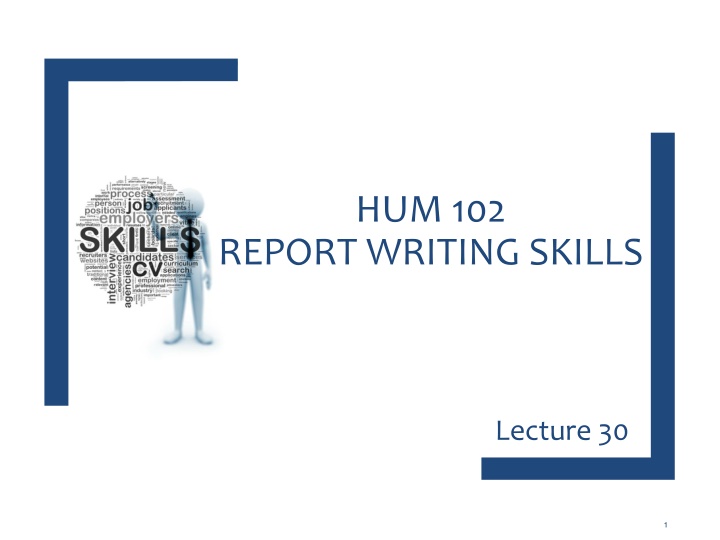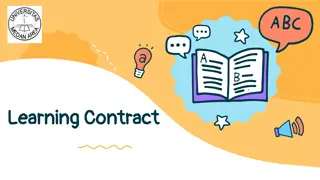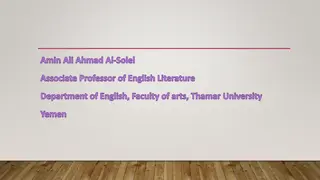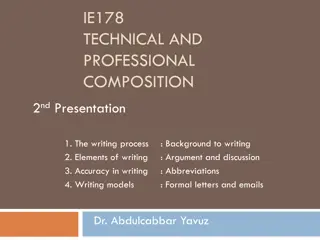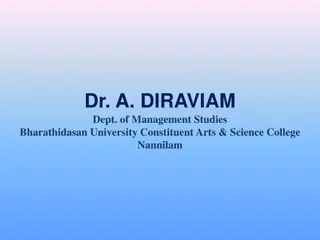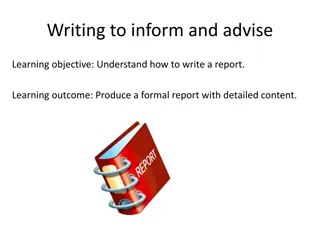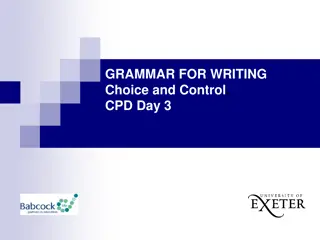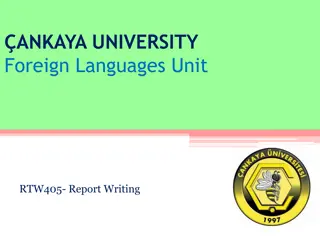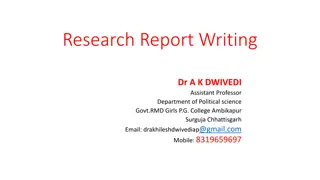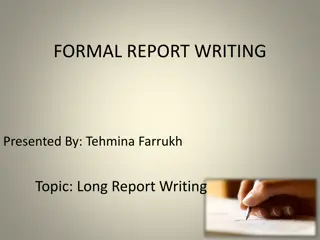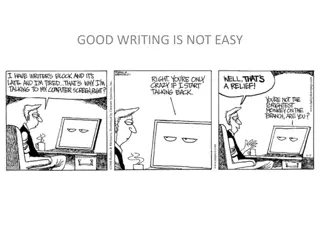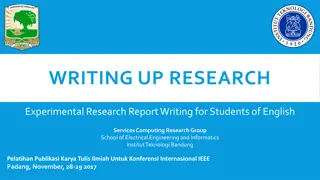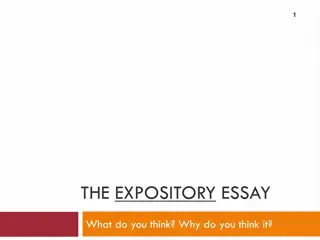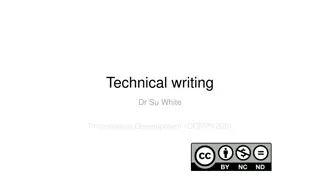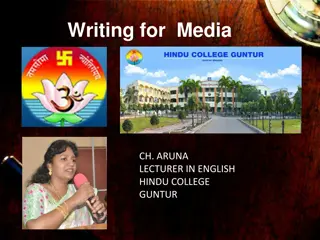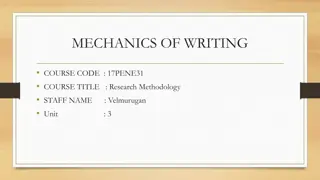Essential Aspects of Report Writing
A report is a structured document used for informing, persuading, or influencing readers. It involves identification, examination, and organization of a subject or problem. Reports are crucial for professional communication, decision-making, and planning. Learn about the language, structure, and key components of effective report writing in this comprehensive guide.
Download Presentation

Please find below an Image/Link to download the presentation.
The content on the website is provided AS IS for your information and personal use only. It may not be sold, licensed, or shared on other websites without obtaining consent from the author.If you encounter any issues during the download, it is possible that the publisher has removed the file from their server.
You are allowed to download the files provided on this website for personal or commercial use, subject to the condition that they are used lawfully. All files are the property of their respective owners.
The content on the website is provided AS IS for your information and personal use only. It may not be sold, licensed, or shared on other websites without obtaining consent from the author.
E N D
Presentation Transcript
HUM 102 REPORT WRITING SKILLS Lecture 30 1
Introduction to Report Structured form of writing which involves (identification, examination and organization) It is used to inform, persuade, influence and initiate Well planned document which clearly outlines and evaluates a subject/problem Analyses a problem and make recommendations for future actions A medium of professional communication, planning and decision making It is complete, compact, clear and presented in a lucid style 2
Language of a Report The focus of readers varies depending on their nature categorized as: o General Readers: Look for details o Managerial Readers: Executive summary o Technical Readers: More focus towards graphs, figures and tables Prefer active voice and the use of third person Avoid personal pronouns for objectivity Properly cite credible authors 3
Structure of a Report [1/2] Title Page: Title, To, From, Date Executive Summary/Abstract: Qualitative, purpose and outcome with results, no abbreviations (purpose, methods, findings, conclusions, recommendations) Table of Contents: Providing page numbers for all the sections, sub sections, works cited, additional material in appendix Introduction: Background and problem description, objectives, method, expected outcome, scope, limitations Review of Related Literature: Critical thinking, formulating deeper and profound understanding of the problem, credible authors and reliable sources 4
Structure of a Report [2/2] Methodology: Theoretical description of design with brevity Results: Textual explanation accompanied with figures, tables and diagrams Discussions: Developing creative solutions of the problem Conclusions: Comprehensive summary of report s main points and findings, logical deductions, leading towards recommendations Recommendations: what to implement, general applicability, suitability of findings, suggestions for further research with brevity, clarity and precision Works Cited: Using a particular referencing style (MLA/APA/Chicago) Appendices: Detailed and complex tables and figures, questionnaires 5
Mode of Report Writing Deductive Report Writing: For sharing general and neutral information, routine messages (any specific information comes at the end) Inductive Report Writing: Use of specific and factual information to draw conclusion, used for informed readers, used when a resistance is expected from the audience 6
Types of Report Informal Report: Short length and particular formality, written for audience within an organization o Progress Report, Sales Activity Report, Personnel Evaluation, Financial Report, Feasibility Report, Review Report, Credit Report and so on Formal Report: Long and detailed, complex as it involves collection, analysis and the resultant interpretation of data o Informational, Analytical, Recommendation o Additional forms include: narrative, specialized, accident 7
Technical Writing Form of writing which communicates specific and factual information to a defined audience for a defined purpose It developed with the recording of history, increasing literacy, world wars and computer revolution Technical writing covers instructions, direction, policies, technical reports An instructional manual for repairing a machinery, memo listing meeting agendas, letter from a vendor to a client, recommendation report proposing a new computer system Letters, Emails, Memos, Websites, Brochures and so on 8
Objectives/Traits in Technical Writing Clarity: Easily understood by intended audience (active voice, objective, transition words) Conciseness: Brief and crisp (deleting redundancy, doubled words, meaningless words, phrases to words) Accessible Document Design: All the necessary information is present alongside bullets, headings, italics, underlining, graphics Audience Recognition: Audience is specified (high tech requires abbreviations, low tech requires abbreviation with parenthetical definitions, lay requires explanation, multiple, multicultural) Accuracy: Grammatically correct and accurate (peer review, grammar check) 9
The Writing Process: Pre-Writing The invention stage which involves planning about the purpose and defining audience Discovering and narrowing down interest in the subject area There are a variety of basic techniques: o Listing, Rapid Sketches, Conversation, Doodling or Sketching, Circle Technique, Clustering, Freewriting, Note Keeping, Brain Storming, Mind Mapping, o Journalistic Questions, Heuristic Methods (Cubing, Tagmemics, Aristotle s Common Topics, Dramatism) 10
The Writing Process: Drafting Involves composing a draft with order, unity, support (examples) and coherence Order can be chronological (instructions), spatial (technical description), importance (good for reports/memos), problem solution (proposal), comparison contrast (for alternatives) Remember that draft is not the final copy, it is the preliminary piece of writing First research, then organize ideas using convergent/divergent thinking Drafting includes thesis statement (basis of entire paper), topic sentence, supporting details (research), conclusion, all written with unity and coherence 11
The Writing Process: Finishing Responding: Self assessment/peer evaluation Revising: A.R.R.R (adding, rearranging, removing, replacing) Editing: Rereading for grammar/subject verb agreement/word order Proofreading: Final check for headings, spelling, capitalization, punctuation, format and layout (headings, paragraphs, illustration and colors) Publishing 12
7 Cs of Effective Communication [1/2] Clarity: Simplicity and organization, use of familiar words applying LUCE (length, unity, coherence, emphasis) approach Conciseness: Get to the point with minimum use of words and avoid redundancy and filler words Completeness: Nothing important is missed, providing everything required Concreteness: Specifics, providing facts and figures, citing sources appropriately 13
7 Cs of Effective Communication [2/2] Correctness: Factual and grammatical precision, grammar, punctuation, spelling Consideration: Stepping into the shoes of others, making a comprehensible and appealing content, understanding nature of the audience Courtesy: Giving space to audience, understanding feelings and perspectives of the audience, respecting the audience, non- discriminatory expressions, avoiding expressions which may hurt the audience, appreciate the audience 14
Conclusions Introduction to Report Structure of a Report Types of Report Introduction to Technical Writing Objectives of Technical Writing The Writing Process 7 Cs of Communication 15
